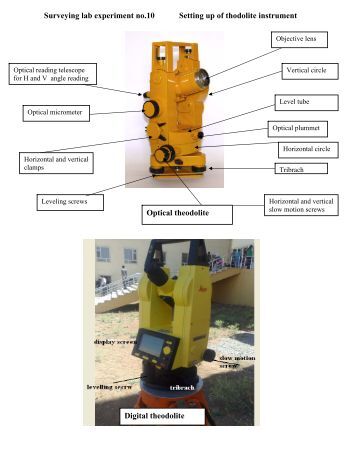USE of THEODOLITE
Introduction
The theodolite is a versatile instrument and is commonly used for the following tasks.
a) Measurement of horizontal angles
b) Measurement of vertical angles
c) Setting out horizontal angles
d) Ranging
e) Levelling
f) Optical distance measurement
g) Controlling verticality
Measurement of horizontal angles
The reiteration method is a common method of observing horizontal angles. The procedure is as follows:
a) Accurately center and level the theodolite over a ground mark
b) Sight the left hand target (face left) with a small reading on the plate using the lower plate clamp and slow motion screw. Do not touch the lower plate again
during this round of angles. If several rounds of angles are to be observed, the initial plate setting is changed by about 90 each time.
c) Sight on to the right hand target(s) using the upper plate clamp and slow motion screw, noting the reading each time.
d) When the last target has been sighted, change face, This is done by rotating the telescope vertically through 180 and the upper plate horizontally though
180 to sight back onto the last target.
e) If face right re-observe all the targets.
f) It is essential that the plate readings are checked for accuracy on completion of each round of angles. Check that there is 180 difference between the
readings. Any variation from the 180 difference is an indication of instrumental error and should be reasonably constant. This will discover gross errors due to
misreading scales, using wrong slow motion screws, sighting wrong targets, etc. The targets can be re-sighted and the readings corrected before changing the
lower plate.
g) Horizontal plate readings and reduced angles can be recorded in a standard field book.
Note the different initial plate settings for each round, the use of the remarks column and the summary of angles.
The operation of one second theodolites is practically the same as that outlined above. The only difference occurs during the initial sighting of the left hand target.
Sight the target first and then set the required plate reading.
Measurement of vertical angles
Vertical angles are useful in applying slope corrections to distance measurement and for determining reduced levels of inaccessible points.
The observing procedure is practically the same for all theodolites.
a) Sight the target with the horizontal cross wire.
b) Level the altitude bubble, unless the instrument has automatic vertical indexing in which case there may be a release button to press
c) After adjusting the micrometer note the plate reading.
d) Change face and repeat
The orientation of the vertical circle varies from one instrument to another and several examples are in Figure 6. Study your theodolite carefully as it is
necessary to reduce vertical angles.

No comments:
Post a Comment